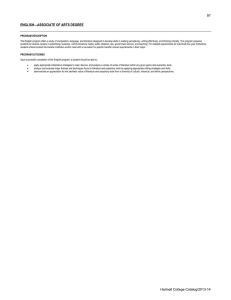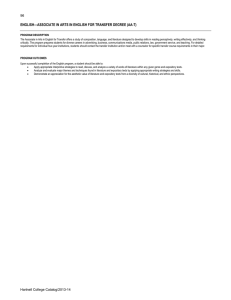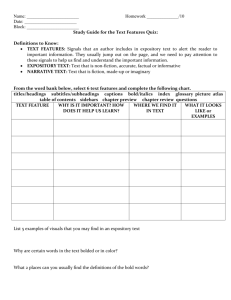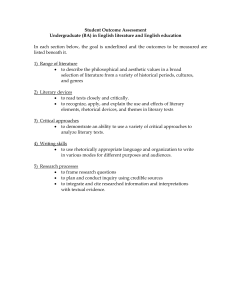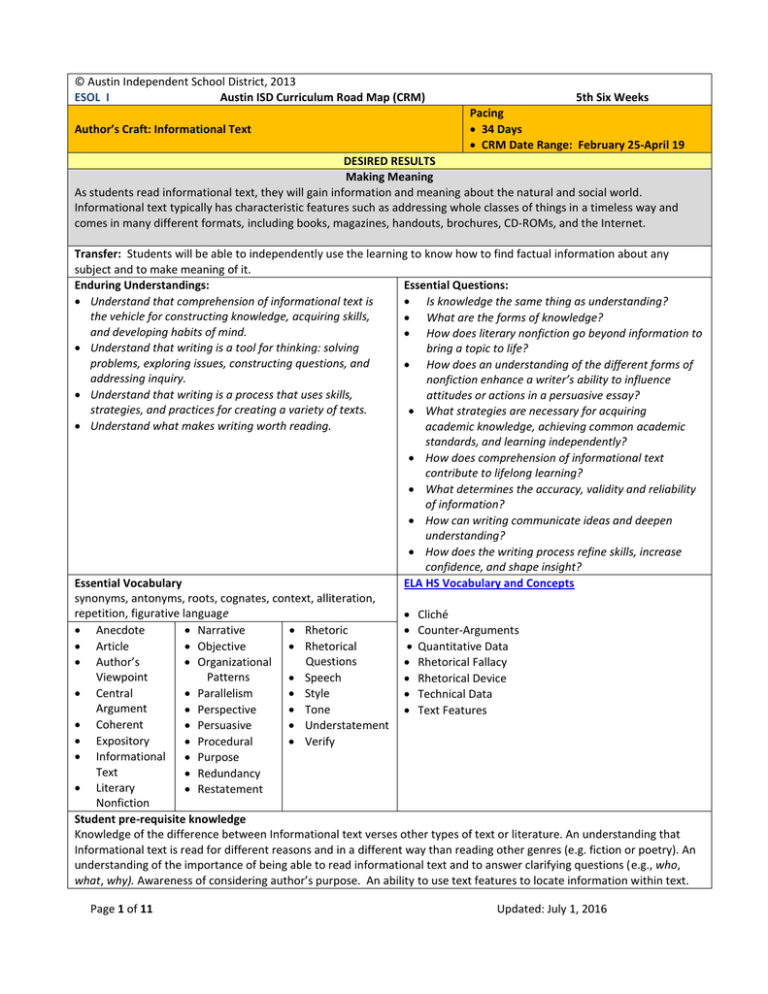
© Austin Independent School District, 2013
ESOL I
Austin ISD Curriculum Road Map (CRM)
Author’s Craft: Informational Text
5th Six Weeks
Pacing
34 Days
CRM Date Range: February 25-April 19
DESIRED RESULTS
Making Meaning
As students read informational text, they will gain information and meaning about the natural and social world.
Informational text typically has characteristic features such as addressing whole classes of things in a timeless way and
comes in many different formats, including books, magazines, handouts, brochures, CD-ROMs, and the Internet.
Transfer: Students will be able to independently use the learning to know how to find factual information about any
subject and to make meaning of it.
Enduring Understandings:
Essential Questions:
Understand that comprehension of informational text is
Is knowledge the same thing as understanding?
the vehicle for constructing knowledge, acquiring skills,
What are the forms of knowledge?
and developing habits of mind.
How does literary nonfiction go beyond information to
Understand that writing is a tool for thinking: solving
bring a topic to life?
problems, exploring issues, constructing questions, and
How does an understanding of the different forms of
addressing inquiry.
nonfiction enhance a writer’s ability to influence
Understand that writing is a process that uses skills,
attitudes or actions in a persuasive essay?
strategies, and practices for creating a variety of texts.
What strategies are necessary for acquiring
Understand what makes writing worth reading.
academic knowledge, achieving common academic
standards, and learning independently?
How does comprehension of informational text
contribute to lifelong learning?
What determines the accuracy, validity and reliability
of information?
How can writing communicate ideas and deepen
understanding?
How does the writing process refine skills, increase
confidence, and shape insight?
Essential Vocabulary
ELA HS Vocabulary and Concepts
synonyms, antonyms, roots, cognates, context, alliteration,
repetition, figurative language
Cliché
Anecdote
Narrative
Rhetoric
Counter-Arguments
Article
Objective
Rhetorical
Quantitative Data
Questions
Author’s
Organizational
Rhetorical Fallacy
Viewpoint
Patterns
Speech
Rhetorical Device
Central
Parallelism
Style
Technical Data
Argument
Perspective
Tone
Text Features
Coherent
Persuasive
Understatement
Expository
Procedural
Verify
Informational Purpose
Text
Redundancy
Literary
Restatement
Nonfiction
Student pre-requisite knowledge
Knowledge of the difference between Informational text verses other types of text or literature. An understanding that
Informational text is read for different reasons and in a different way than reading other genres (e.g. fiction or poetry). An
understanding of the importance of being able to read informational text and to answer clarifying questions (e.g., who,
what, why). Awareness of considering author’s purpose. An ability to use text features to locate information within text.
Page 1 of 11
Updated: July 1, 2016
Development of academic language and grammatical structures are a major factor in academic success of ELLs. In addition,
ELLs are acquiring English language at the same time they are learning content in English. ELLs are expected to meet the
same standards in a second language that many monolingual English speakers find difficult in their first language.
Resources:
Glencoe ELLevate Teacher Resource:
Pearson Longman Keystone 1B Teacher Edition
Strategies for ELLs www.ellevate.glencoe.com
Longman Keystone Teacher’s Resource Book
A+RISE online ELPS resource in Project Share
http://www.epsilen.com or www.arises2s.com/texas
Longman Keystone Placement & Exit Test
Longman Keystone Student Text
The ELAR textbook adopted by Austin ISD has these ELL
Longman Keystone Student Workbook
resources:
Longman Keystone Reader’s Companion
Prentice-Hall Literature Reader’s Notebook English
Longman Keystone Student e-book CD ROM
Learner’s
Longman Keystone Assessment book,
version (9, 10, 11, 12)
Longman Keystone Transparencies
Prentice-Hall
Literature Reader’s Notebook Spanish
Longman Keystone Program Audio CD
version
(9,
10,
11, 12)
Longman Keystone Teacher e-book & Examview CD
Prentice-Hall
Teacher’s
Edition Language Central (9,
Longman Keystone Video Program DVD
10,no
11
or
12)
Longman Keystone Phonics Kit- includes flash cards,
5 student workbooks,2 readers A & B, 1 Teacher’s Edition www.PHLitOnline.com
Six Traits of Writing pamphlet
Penguin Readers-18 readers
Online Success tracker and essay scorer
www.pearsonsuccessnet.com
Longman Keystone Texas website
http://www.texasesol.com and
http://portal.mypearson.com/mypearson-login.jsp
Prentice Hall Literature Texas edition, (Selections by
Grade, Genre, and Lexile, English II Writing Resources,
ELA curriculum documents and resources
ELPS: Mandated by Texas Administrative Code (19 TAC §74.4), click on the link for English Language Proficiency Standards
(ELPS) to support English Language Learners.
Arc Pacing: 2 Weeks
ARC #1: Comparing Expository and Persuasive
Targeted Vocabulary: auditorium, concert, congregation, determination, injustice, spirituals, legislation, reinstated,
mandatory, stereotyped
Resources: English I TEKS, Texas College Career and Readiness Standards (CCRS), Technology Application TEKS
TEKS Knowledge & Skills
Acquisition Important knowledge and skills
STAAR: RC = Reporting Category; DC =
Students Will Know
Students Will Be Able To
Dual Coded Skills; Readiness Standard;
Supporting Standard Concepts are
addressed in another unit.
E1.8 Reading/Comprehension of Informational Text/Culture and History. Students analyze, make inferences and draw
conclusions about the author's purpose in cultural, historical, and contemporary contexts and provide evidence from the
text to support their understanding. The student is expected to:
(8A) explain the controlling idea and
Authors write for specific purposes Demonstrate English
specific purpose of an expository text
to specific audiences.
comprehension and expand
and distinguish the most important from
reading skills by employing
The central idea of a work is
the less important details that support
inferential skills such as predicting,
created by details and some of the
the author's purpose RC3
making connections between
details are more important than
ideas, drawing inferences and
others.
conclusions from text and graphic
sources, and finding supporting
During reading, it is the reader’s
text evidence commensurate with
job to differentiate between minor
Page 2 of 11
Updated: July 1, 2016
and major details.
content-area needs
Demonstrate English
comprehension and expand
reading skills by employing
analytical skills such as evaluating
written information and
performing.
Demonstrate analyze and evaluate
the central message of an
expository text and make unique
connections to relevant text.
Evaluate the author’s purpose and
make unique personal and literary
connections.
Analyze the structure of the text
and relevance of both important
and less important details.
Choose relevant, specific and
meaningful textual evidence to
support his or her analysis.
E1.9 Reading/Comprehension of Informational Text/Expository Text. Students analyze, make inferences and draw
conclusions about expository text and provide evidence from text to support their understanding. The student is expected
to:
(9A) summarize text and distinguish
How to determine the meaning of Demonstrate English
between a summary that captures the
unknown words using common
comprehension and expand
main ideas and elements of a text and a
affixes and resources such as
reading skills by employing basic
critique that takes a position and
dictionaries.
reading skills such as
expresses an opinion RC3
demonstrating understanding of
Compare attitudes and beliefs
(9B) differentiate between opinions that
supporting ideas and details in text
between and among texts from
are substantiated and unsubstantiated
and graphic sources, summarizing
the same period gives a
in the text RC3
text, and distinguishing main ideas
perspective on how literature and
(9C) make subtle inferences and draw
from details commensurate with
society are connected.
complex conclusions about the ideas in
content-area needs.
text and their organizational patterns
Develop and expand repertoire of
RC3
learning strategies such as
(9D) synthesize and make logical
reasoning inductively or
connections between ideas and details
deductively, looking for patterns in
in several texts selected to reflect a
language, and analyzing sayings
range of viewpoints on the same topic
and expressions. Define unknown
and support those findings with textual
words prior to reading and as they
evidence RC1
read the text and what resources
are most helpful.
E1.10 Reading/Comprehension of Informational Text/Persuasive Text. Students analyze, make inferences and draw
conclusions about persuasive text and provide evidence from text to support their analysis. The student is expected to:
(10A) analyze the relevance, quality,
Authors create texts in order to
Demonstrate English
and credibility of evidence given to
inform, persuade, entertain, or a
comprehension and expand
support or oppose an argument for a
mixture of the three.
reading skills by employing
specific audience RC3
analytical skills such as evaluating
Persuasion can greatly impact
Page 3 of 11
Updated: July 1, 2016
(10B) analyze famous speeches for the
rhetorical structures and devices used to
convince the reader of the authors'
propositions RC3
society.
Using effective arguing strategies
will help a writer build a strong
case in support of the writer’s
position.
written information and
performing.
Evaluate a reading and find
evidence within the text to
support their understanding.
E1.15 Writing/Expository and Procedural Texts. Students write expository and procedural or work-related texts to
communicate ideas and information to specific audiences for specific purposes. The student is expected to:
(15Ai) effective introductory and
concluding paragraphs and a variety of
sentence structures RC4/RC5
(15Aii) rhetorical devices, and
transitions between paragraphs
RC4/RC5
(15Aiii) a controlling idea or thesis
RC4/RC5
(15Aiv) an organizing structure
appropriate to purpose, audience, and
context RC4/RC5
(15Av) relevant information and valid
inferences RC4/RC5
Thesis statements need to show
an interpretation of a work, not
merely a summary.
Main points grow out of the
thesis statement.
Specific evidence and details are
necessary to make a convincing
point.
Write using a variety of gradeappropriate sentence lengths,
patterns, and connecting words
to combine phrases, clauses,
and sentences in increasingly
accurate ways as more English is
acquired.
Communicate in writing their
ideas and/or procedural or other
expository information to a
specific target group of readers.
ARC #2: Reading Procedural Text
Arc Pacing: 0.5 weeks
Targeted Vocabulary: constantly, contract, network, regulate, transport, circulate,
Resources: English I TEKS, Texas College Career and Readiness Standards (CCRS), Technology Application TEKS
TEKS Knowledge & Skills
Acquisition Important knowledge and skills
STAAR: RC = Reporting Category; DC =
Students Will Know
Students Will Be Able To
Dual Coded Skills; Readiness Standard;
Supporting Standard Concepts are
addressed in another unit.
E1.11 Reading/Comprehension of Informational Text/Procedural Texts. Students understand how to glean and use
information in procedural texts and documents. Students are expected to:
(11A) analyze the clarity of the
Procedural texts provide directions Demonstrate English
objective(s) of procedural text (e.g.,
or instructions.
comprehension and expand
consider reading instructions for
reading skills by employing
Authors use clear language in text
software, warranties, consumer
inferential skills such as predicting,
that explains a process to ensure
publications) RC3
making connections between
that the correct steps are followed
(11B) analyze factual, quantitative, or
ideas, drawing inferences and
to achieve the goal.
technical data presented in multiple
conclusions from text and graphic
graphical sources RC3
sources, and finding supporting
Charts, graphs and images
text evidence commensurate with
provided in text and electronically
content area needs.
contribute to a reader’s
understanding of the information.
Find and use procedural or other
types of factual information from
within texts and other documents
which are relevant to their needs
E1.14 Writing/Literary Texts. Students write literary texts to express their ideas and feelings about real or imagined
people, events, and ideas. Students are responsible for at least two forms of literary writing. Students are expected to:
Page 4 of 11
Updated: July 1, 2016
(14A) write an engaging story with a
well-developed conflict and resolution,
interesting and believable characters,
and a range of literary strategies (e.g.,
dialogue, suspense) and devices to
enhance the plot RC4
Defining the conflict and
resolution of a story is essential in
the planning process
Literary elements work together
like pieces in a puzzle to create
meaning.
To create believable characters,
authors ensure that characters
function in accordance to the
character’s motivation.
Narrate, describe, and explain
with increasing specificity and
detail to fulfill content area
writing needs as more English is
acquired. Write a well thought
out story which uses literary
strategies and devices to keep
the reader engaged.
Arc #3: Comparing Expository to Literary Nonfiction
Arc Pacing: 1Week
Targeted Vocabulary: isolated, relocate, survival, temporary, diction, tone
Resources: English I TEKS, Texas College Career and Readiness Standards (CCRS), Technology Application TEKS
TEKS Knowledge & Skills
Acquisition Important knowledge and skills
STAAR: RC = Reporting Category; DC =
Students Will Know
Students Will Be Able To
Dual Coded Skills; Readiness Standard;
Supporting Standard Concepts are
addressed in another unit.
E1.6 Reading/Comprehension of Literary Text/Literary Nonfiction. Students understand, make inferences and draw
conclusions about the varied structural patterns and features of literary nonfiction and provide evidence from text to
support their understanding. The student is expected to:
(6A) analyze how literary essays
An author purposefully chooses a
Read linguistically accommodated
interweave personal examples and ideas
specific text structure to produce a
content area material with a
with factual information to explain,
desired effect on the reader.
decreasing need for linguistic
present a perspective, or describe a
accommodations as more English
Understand that the devices and
situation or event RC2
is learned.
styles used in literary essays and
nonfiction are to aid in a readers
Use features of a text to better
perception and comprehension of
understand.
the topic.
E1.8 Reading/Comprehension of Informational Text/Culture and History. Students analyze, make inferences and draw
conclusions about the author's purpose in cultural, historical, and contemporary contexts and provide evidence from the
text to support their understanding. Students are expected to:
(8A) explain the controlling idea and
Authors use both important and
emonstrate English
specific purpose of an expository text
less important details in
comprehension and expand
and distinguish the most important from
informational texts.
reading skills by employing
the less important details that support
inferential skills such as predicting,
the author's purpose RC3
making connections between
ideas, drawing inferences and
conclusions from text and graphic
sources, and finding supporting
text evidence commensurate with
content area needs.
Understand what the author’s
perspective/point of view is about
a topic and be able to cite
evidence from the reading which
support that view.
E1.9 Reading/Comprehension of Informational Text/Expository Text. Students analyze, make inferences and draw
conclusions about expository text and provide evidence from text to support their understanding. Students are expected
Page 5 of 11
Updated: July 1, 2016
to:
(9A) summarize text and distinguish
How to determine the meaning
evelop and expand repertoire of
between a summary that captures the
of unknown words using
learning strategies such as
main ideas and elements of a text and a
common affixes and resources
reasoning inductively or
critique that takes a position and
such as dictionaries.
deductively, looking for patterns
expresses an opinion RC3
in language, and analyzing
Comparing attitudes and beliefs
(9B) differentiate between opinions that
sayings and expressions
between and among texts from
are substantiated and unsubstantiated
commensurate with grade-level
the same period gives a
in the text RC3
learning expectations.
perspective on how literature
(9C) make subtle inferences and draw
and society are connected.
Use the information they read to form
complex conclusions about the ideas in
opinions, make judgments, and draw
text and their organizational patterns
conclusions.
RC3
(9D) synthesize and make logical
connections between ideas and details
in several texts selected to reflect a
range of viewpoints on the same topic
and support those findings with textual
evidence RC1
E1.15 Writing/Expository and Procedural Texts. Students write expository and procedural or work-related texts to
communicate ideas and information to specific audiences for specific purposes. Students are expected to:
(15Ai) effective introductory and
Thesis statements need to show
Write using a variety of gradeconcluding paragraphs and a variety of
an interpretation of a work, not
appropriate sentence lengths,
sentence structures RC4/RC5
merely a summary.
patterns, and connecting words to
(15Aii) rhetorical devices, and
combine phrases, clauses, and
Main points grow out of the
transitions between paragraphs
sentences in increasingly accurate
thesis statement.
RC4/RC5
ways as more English is acquired.
(15Aiii) a controlling idea or thesis
Specific evidence and details are
Communicate in writing their ideas
RC4/RC5
necessary to make a convincing
and/or procedural or other
(15Aiv) an organizing structure
point.
expository information to a
appropriate to purpose, audience, and
specific target group of readers.
context RC4/RC5
(15Av) relevant information and valid
inferences RC4/RC5
(15Ci) write an interpretative response to
an expository or a literary text (e.g.,
essay or review) that extends beyond a
summary and literal analysis
(15Cii) write an interpretative response
to an expository or a literary text (e.g.,
essay or review) that addresses the
writing skills for an analytical essay and
provides evidence from the text using
embedded quotations
(15Ciii) write an interpretative response
to an expository or a literary text (e.g.,
essay or review) that analyzes the
aesthetic effects of an author's use of
stylistic or rhetorical devices
Arc Pacing: 1Week
ARC #4: Comparing Informational Text to Poetry
Targeted Vocabulary: Figurative language: metaphor, simile, personification, onomatopoeia, imagery, Poetic Sound
devices: rhythm, rhyme, alliteration, repetition
Page 6 of 11
Updated: July 1, 2016
Resources: English I TEKS, Texas College Career and Readiness Standards (CCRS), Technology Application TEKS
Keystone 1B, Unit 5, CD-ROM, Audio CD 5, track 6, Workbook
TEKS Knowledge & Skills
Acquisition Important knowledge and skills
STAAR: RC = Reporting Category; DC =
Students Will Know
Students Will Be Able To
Dual Coded Skills; Readiness Standard;
Supporting Standard Concepts are
addressed in another unit.
E1.3 Reading/Comprehension of Literary Text/Poetry. Students understand, make inferences and draw conclusions about
the structure and elements of poetry and provide evidence from text to support their understanding. Students are
expected to:
3(A) analyze the effects of diction and
Poets create meaning through
Understand the devices and styles
imagery (e.g., controlling images,
word choice and imagery. The
used in poetry and what effect
figurative language, understatement,
academic terms associated with
they have on a readers perception
overstatement, irony, paradox) in poetry.
the analysis of poetry.
of the piece.
RC2-SS
The way poets use sound
Reference evidence of specific
qualities, like rhyme scheme and
elements within a poetry piece.
metrics, to convey meaning much
Develop and expand repertoire of
in the way music does.
learning strategies such as
reasoning inductively or
deductively, looking for patterns in
language, and analyzing sayings
and expressions commensurate
with grade-level learning
expectations.
E1.9 Reading/Comprehension of Informational Text/Expository Text. Students analyze, make inferences and draw
conclusions about expository text and provide evidence from text to support their understanding. Students are expected
to:
(9A) summarize text and distinguish
Students will know how to
Use the information they read to form
between a summary that captures the
determine the meaning of
opinions, make judgments, and draw
main ideas and elements of a text and a
unknown words using common
conclusions.
critique that takes a position and
affixes and resources such as
Develop and expand repertoire of
expresses an opinion RC3
dictionaries.
learning strategies such as
9B differentiate between opinions that
Comparing attitudes and beliefs
reasoning inductively or
are substantiated and unsubstantiated
between and among texts from
deductively, looking for patterns
in the text RC3
the same period gives a
in language, and analyzing
(9C) make subtle inferences and draw
perspective on how literature and
sayings and expressions
complex conclusions about the ideas in
society are connected.
commensurate with grade-level
text and their organizational patterns
learning expectations.
RC3
(9D) synthesize and make logical
connections between ideas and details
in several texts selected to reflect a
range of viewpoints on the same topic
and support those findings with textual
evidence RC1
E1.10 Reading/Comprehension of Informational Text/Persuasive Text. Students analyze, make inferences and draw
conclusions about persuasive text and provide evidence from text to support their analysis. Students are expected to:
(10A) analyze the relevance, quality,
Page 7 of 11
Authors create texts in order to
Demonstrate English
Updated: July 1, 2016
and credibility of evidence given to
support or oppose an argument for a
specific audience RC3
(10B) analyze famous speeches for the
rhetorical structures and devices used to
convince the reader of the authors'
propositions RC3
inform, persuade, entertain, or a
mixture of the three.
Persuasion can greatly impact
society.
using effective arguing strategies
will help a writer build a strong
case in support of the writer’s
position.
comprehension and expand
reading skills by employing
analytical skills such as
evaluating written information
and performing Evaluate a
reading and find evidence within
the text to support their
understanding.
E1.11 Reading/Comprehension of Informational Text/Procedural Texts. Students understand how to glean and use
information in procedural texts and documents. Students are expected to:
(11A) analyze the clarity of the
Students will know procedural
Demonstrate English
objective(s) of procedural text (e.g.,
texts provide directions or
comprehension and expand
consider reading instructions for
instructions.
reading skills by employing
software, warranties, consumer
inferential skills such as
Charts, graphs and images
publications) RC3
predicting, making connections
provided in text and electronically
between ideas, drawing
(11B) analyze factual, quantitative, or
contribute to a reader’s
inferences and conclusions from
technical data presented in multiple
understanding of the information.
text and graphic sources, and
graphical sources RC3
finding supporting text evidence
commensurate with content
area needs.
Find and use procedural or other
types of factual information
from within texts and other
documents which are relevant
to their needs.
E1.15 Writing/Expository and Procedural Texts. Students write expository and procedural or work-related texts to
communicate ideas and information to specific audiences for specific purposes. Students are expected to:
(15Ai) effective introductory and
Thesis statements need to show
Write using a variety of gradeconcluding paragraphs and a variety of
an interpretation of a work, not
appropriate sentence lengths,
sentence structures RC4/RC5
merely a summary.
patterns, and connecting words
to combine phrases, clauses,
(15Aii) rhetorical devices, and
Main points grow out of the
and sentences in increasingly
transitions between paragraphs
thesis statement.
accurate ways as more English is
RC4/RC5
acquired.
Specific evidence and details are
(15Aiii) a controlling idea or thesis
necessary to make a convincing
Communicate in writing their
RC4/RC5
point.
ideas and/or procedural or other
(15Aiv) an organizing structure
expository information to a
appropriate to purpose, audience, and
specific target group of readers.
context RC4/RC5
Writing follows basic writing
(15Av) relevant information and valid
fundamentals and structure.
inferences RC4/RC5
Provide evidence in writing of
(15Ci) write an interpretative response to
thoughtful interpretation of an
an expository or a literary text (e.g.,
expository or literary text.
essay or review) that extends beyond a
summary and literal analysis
(15Cii) write an interpretative response to
an expository or a literary text (e.g.,
essay or review) that addresses the
Page 8 of 11
Updated: July 1, 2016
writing skills for an analytical essay and
provides evidence from the text using
embedded quotations
15Ciii write an interpretative response to
an expository or a literary text (e.g.,
essay or review) that analyzes the
aesthetic effects of an author's use of
stylistic or rhetorical devices
Page 9 of 11
Updated: July 1, 2016
ASSESSMENT EVIDENCE
TEA mandate requires the use of linguistic accommodations for ELLs as determined by the LPAC.
Data is available from the LPAS (Language Proficiency Assessment System.)
Refer to http://www.tea.state.tx.us/student.assessment/accommodations.
Student Work Products/Assessment Evidence
Performance Tasks
Other Evidence (i.e. unit tests, open ended exams, quiz, essay,
Choose from the tasks below based on ELL
proficiency level and your pacing.
Summarize the important events in a role
model’s (e.g. Marian Anderson’s) life, including
dates.
Answer comprehension questions.
Discuss questions with a partner or in a small
group and retell or summarize main points to the
rest of the class.
Compare and contrast the emotions people were
feeling in the poems (about people during the
time of war)
Students take turns reading the selection aloud
Research information about the circulatory
system in encyclopedia or on internet
Answer comprehension questions
Define and discuss any unfamiliar words or
terminology
Partners discuss how war changes people’s lives.
Partners use key words in a cause-and-effect
chart to discuss the reading.
Write headlines that would relate to story.
Write a diary entry from the point of view of a
character in the story.
Discuss what it would be like to be on a
battlefield. Share any personal knowledge of
people who have been in a war.
student work samples, observations, etc.)
Short Cycle Assessment
▼▼▼▼▼
STAAR ASSESSMENT
Writing: April 1st
Reading: April 2nd
▲▲▲▲▲
Additional Suggestions for Assessment
Use a time line
Students analyze illustrations
On-the-spot, ongoing opportunities to determine the extent of
students’ learning. Includes teacher observations, anecdotal
reports, informal conversations with students, quick-writes.
Ask Literary Check questions and extend these into open-ended
classroom discussion
Answer comprehension questions
Students write a letter as if they were in the story and writing to
people back home; students encouraged to share their letter with
the class
GIST summarizing strategy for most important words or concepts
Structured review – summarizing with partners, listing key points
4 Corners poster– 1 question about reading per poster, groups
rotate so that each group responds to each question
Informal – on the spot and ongoing
Teacher observations, anecdotal
Round table discussion – 1 question per table group
Use of student workbooks
Accountable talk
Jigsaw reading – chunk by groups, share out.
Read poem, and with a partner, circle examples
of figurative language; underline examples of
personification.
Compare and contrast the emotions people
were feeling in the poems (about people during
the time of war.)
Page 10 of 11
Updated: July 1, 2016
LESSON PLANNING TOOLS
Teacher Notes
1. Additional text selections at different lexile levels are available in the Resources section, p 2 of this CRM.
(See link: Prentice Hall Literature Texas edition, (Selections by Grade, Genre, and Lexile, English II Writing
Resources)
2. Several lessons are included for each arc. Choose lessons based on proficiency of your ELLs and pacing
considerations.
In the course of lesson planning, it is the expectation that teachers will include whole child considerations when
planning such as differentiation, special education, English language learning, dual language, gifted and talented, social
emotional learning, physical activity, and wellness.
ESOL Exemplar Lesson – Arc 1: Comparing Expository and Persuasive. Longman Keystone 1B, Unit 3 “Marian Anderson, A
Voice for Change” pg. 210; “Helmet Laws in Texas”; “High School Uniforms” pg. 220
Suggested Pacing: 2 weeks
TEKS: 8, 8A, 9, 9A, 9B, 10, 10A
ELA Exemplar Lesson - Arc 1: Author’s Craft: Comparing Expository and Persuasive Text
Suggested Pacing: 3 blocks
TEKS: 9, 9A, 9B, 10, 10A
ESOL Exemplar Lesson 1 – Arc 2: Reading Procedural Texts, Longman Keystone 1B, Unit 4 “The Heart, Our Circulatory
System” pg. 281, “Heart Healthy Recipe” pg. 285
Suggested Pacing: 3 days
TEKS: 11, 11A, 11B
ELA Exemplar Lesson - Arc 2: Author’s Craft: Procedural Text
Suggested Pacing: 1 block
TEKS: 11, 11A, 11B
ESOL Exemplar Lesson 1 – Arc 3: Comparing Expository to Literary Nonfiction. Longman Keystone 1B, Unit 4, “From
Farewell to Manzanar”, pg. 373
Resources, Summaries, pg. 161-162, Audio CD 5, track 21
Suggested Pacing: 1 week
TEKS: 6, 6A, 8, 15, 15Ciii
ELA Exemplar Lesson - Arc 3: Author’s Craft: Comparing Expository and Literary Nonfiction
Pacing: 1 block
TEKS: 6, 6A, 8, 8A
ESOL Exemplar Lesson 1 – Arc 4: Comparing Informational Text to Poetry. Prentice-Hall Literature Reader’s Notebook
English Learner’s (grade 9), Poetry Collection 1, Longman Keystone 1B, Unit 5, “In Flanders Fields” pg. 348, “Three
Wonderful Letters from Home” pg.350
Suggested Pacing: 1 week
TEKS: 3, 3A,15, 15Ci
ELA Exemplar Lesson - Arc 4: Author’s Craft: Comparing Poetry and Informational Text
Suggested Pacing
TEKS: 3, 3A, 9, 9C
Instructional Resource
Comparing Expository and Persuasive
www.starfall.com
Austin ISD ELL Academic Plan 2013-2014, Resources pp.
160-164. (hyperlink takes you to aisdweb intranet)
www.pumarosa.com
Navigating the ELPS in the English Language Arts and
www.eflnet.com
Reading Classroom: Using the Standards to improve
www.daveseslcafe.com
instruction for ELLs, (J. Seiditz).
www.colorincolorado.org
English I STAAR Writing Resources
http://www.misd.net/bilingual/ELL.pdf
Page 11 of 11
Updated: July 1, 2016

